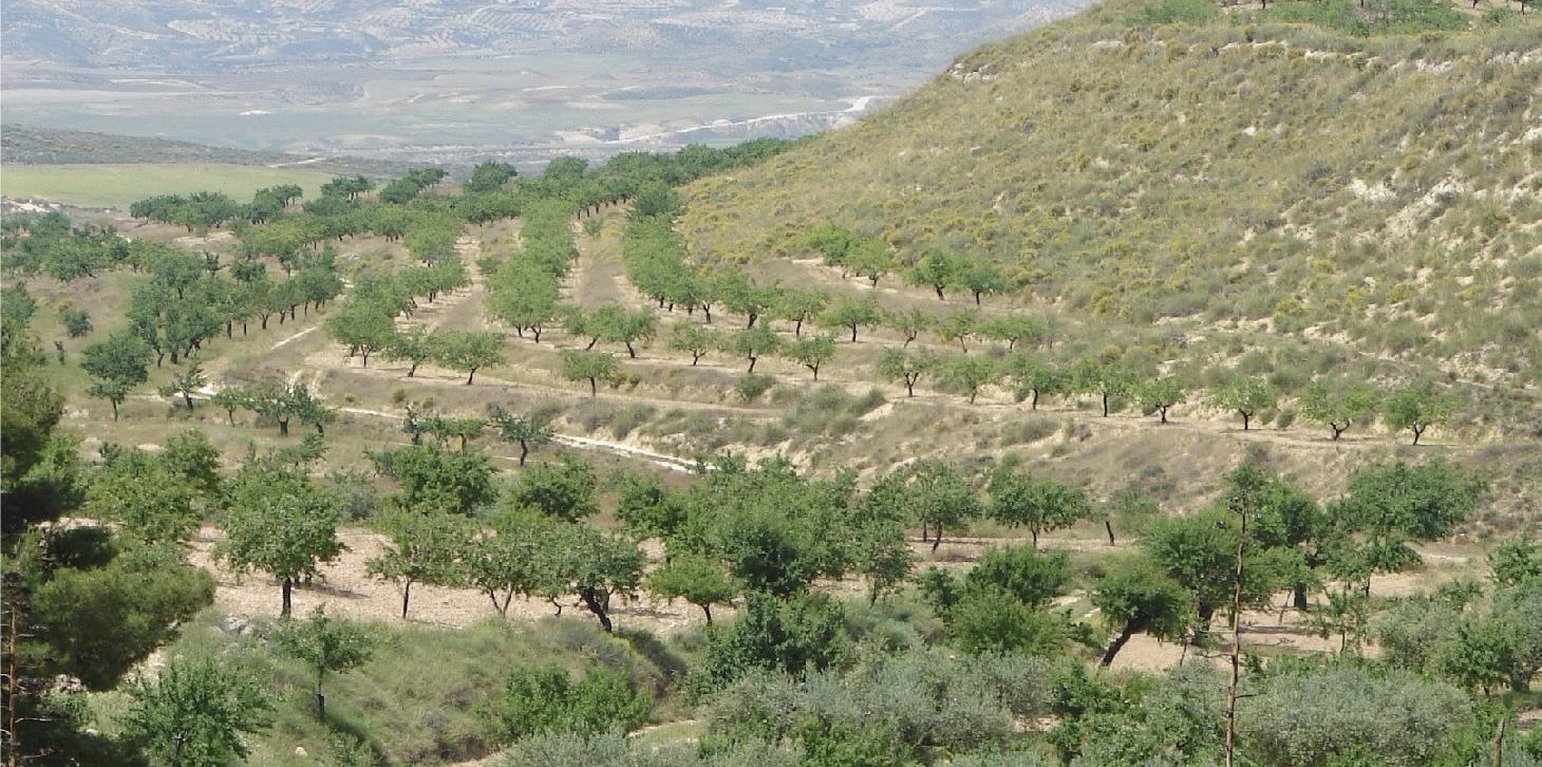



Earth-banked terraces are constructed by carefully removing a superficial soil layer (~10-20 cm) from one part of a field, concentrating it on the lower end of that field in order to reduce slope gradient and length. Another terrace is created directly downslope to form a cascade of terraces. Terrace risers have to be of restricted height (~50-150 cm) to prevent steep and unstable terraces. Stones from the fields can be used to reinforce the terrace ridge. After terrace construction, fields should be gently sloping (<3%) in the direction of the main slope. The distance between terraces must be enough to allow tractor movement during normal cultivation activities and it depends also on the slope gradient. The steeper the slope, the shorter is the distance between terraces. Terraces reduce the formation of gullies and retain water from upslope. The terraces are made with locally available machinery (tractor, small bulldozer). The terrace ridges are optimal locations to plant olives, almonds or fruit trees. Moreover, to be most effective, the terrace ridges are vegetated with shrubs adapted to semi-arid conditions and with a good surface cover (>~30%) throughout the year (e.g. Stipa tenacisima, Rosmarinus officinalis, Thymus vulgaris, Ulex parviflorus, Rhamnus lycioides, Pistacia lentiscus). Natural regeneration of vegetation is allowed without limitation on the terrace ridges, so no herbicide application or burning are carried out to remove weeds. Where possible, regeneration should be stimulated by planting the same adapted species in at least 25% of the terrace ridge. Optionally, in the other 75% of the terrace ridge, cereals or other leguminous species can be sown, but should not be harvested or used for grazing.
Purpose of the Technology: This technology reduces flooding, damage to infrastructure and siltation of water reservoirs, while maintaining (or slightly increasing) crop productivity. This is achieved by reducing runoff, soil erosion and hydraulic connectivity through a decreased slope gradient and an increased vegetation cover. The terrace ridge functions as a sink for runoff within fields and reduces runoff velocity. The vegetation leads to increased soil organic matter content below plants, producing an improved soil structure and a higher infiltration capacity. The use of stones from the fields to reinforce the terraces is optional, but facilitates crop production in the fields and makes the ridges more resistant to higher runoff velocities. The technology requires an initial investment in the construction of the terraces. Terraces can best be located on thalwegs and on areas where gully formation is often observed. Maintenance consists of filling up possible bank gullies developed in the terraces after important rainfall events and, if needed, substitute decayed shrubs with new ones.
Natural / human environment: The technology is generally applied on soils of shallow to medium depth (20 – 60 cm), and slopes are gentle to moderate (5-15%). The climate is semi-arid with a mean annual rainfall around 300 mm. Droughts, peaking in summer commonly last for more than 4-5 months. Annual potential evapotranspiration rates larger than 1000 mm are common. The production system is highly mechanized and market-oriented but depends strongly on agricultural subsidies. All cropland is privately-owned.
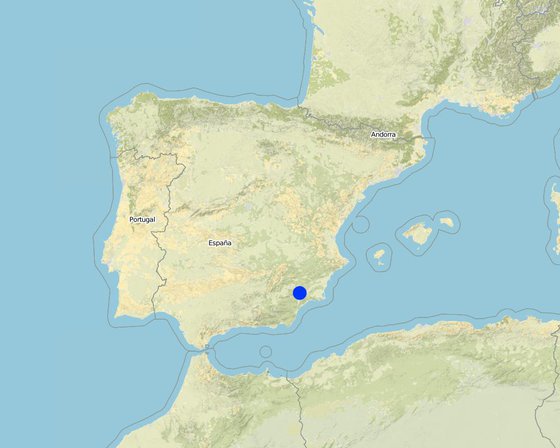
Location: Guadalentin catchment, Murcia, Spain
No. of Technology sites analysed:
Spread of the Technology: evenly spread over an area (approx. 10-100 km2)
In a permanently protected area?:
Date of implementation: more than 50 years ago (traditional)
Type of introduction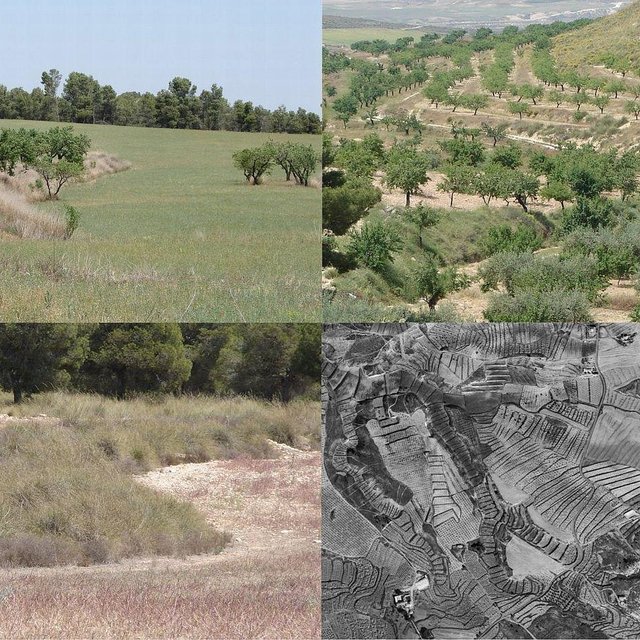
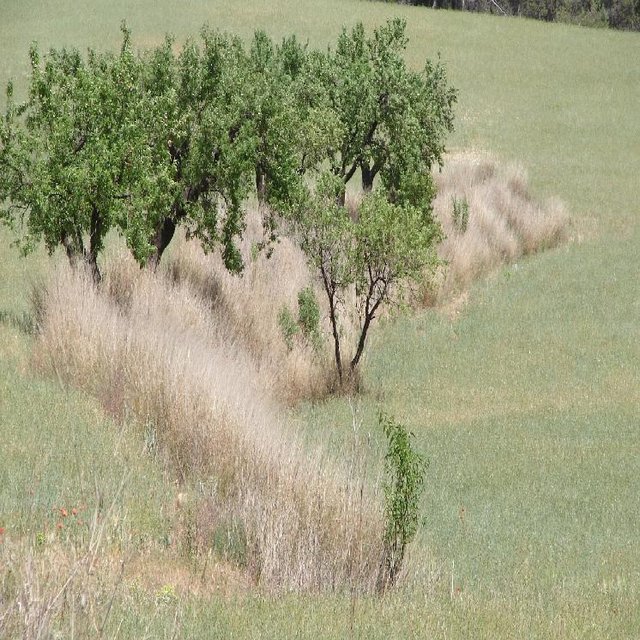







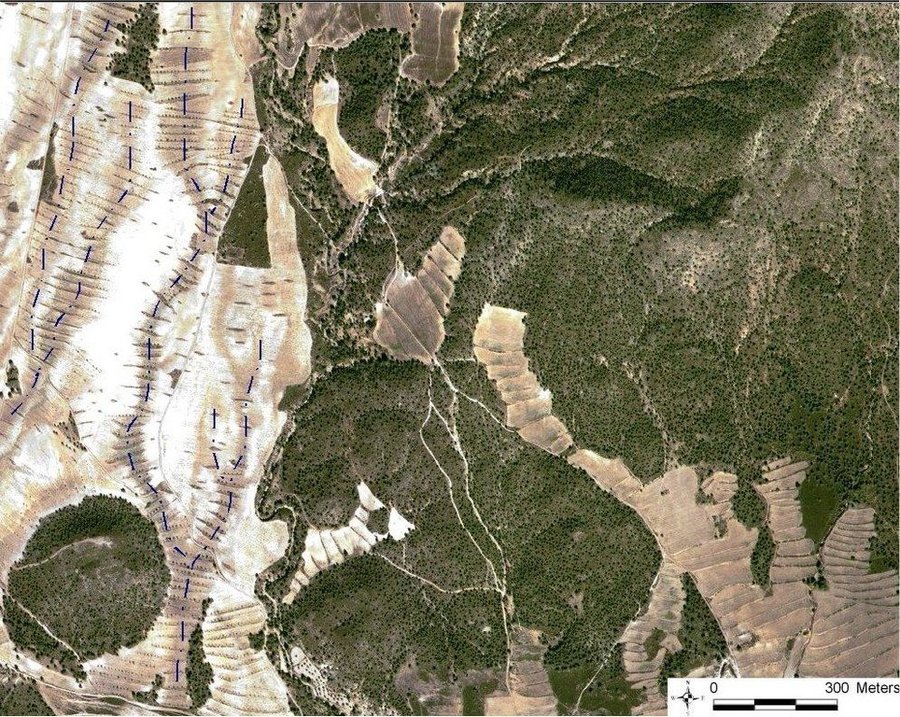
| Specify input | Unit | Quantity | Costs per Unit (EURO) | Total costs per input (EURO) | % of costs borne by land users |
| Labour | |||||
| Labour | ha | 1.0 | 270.0 | 270.0 | 10.0 |
| Equipment | |||||
| Machine use | ha | 1.0 | 428.0 | 428.0 | 12.0 |
| Plant material | |||||
| shrub seedlings and seeds | ha | 1.0 | 218.0 | 218.0 | 10.0 |
| Total costs for establishment of the Technology | 916.0 | ||||
| Total costs for establishment of the Technology in USD | 1'453.97 | ||||
| Specify input | Unit | Quantity | Costs per Unit (EURO) | Total costs per input (EURO) | % of costs borne by land users |
| Labour | |||||
| Labour | ha | 1.0 | 28.0 | 28.0 | 10.0 |
| Equipment | |||||
| Machine use | ha | 1.0 | 24.0 | 24.0 | 10.0 |
| Plant material | |||||
| Shrub seedlings and seeds | ha | 1.0 | 22.0 | 22.0 | 10.0 |
| Total costs for maintenance of the Technology | 74.0 | ||||
| Total costs for maintenance of the Technology in USD | 117.46 | ||||
Depending on local conditions yield may be the same or increase slightly
Field paths become shorter, so more tractor movement is required (not more kilometres!)
Implementation of terraces is considered relatively expensive
Depends on crop yield.
Less damage to fields due to less gully formation
Less damage to neighbours fields by gullies and flooding
There is less damage to fields and to infrastructure due to gully formation and flooding.
On the long term higher infiltration capacity of the soil
Vegetation on the terraces increases vegetation cover
Provided by the vegetation on the terraces
Provided by the vegetation on the terraces
Terraces provide corridors connecting fields and provide shelter